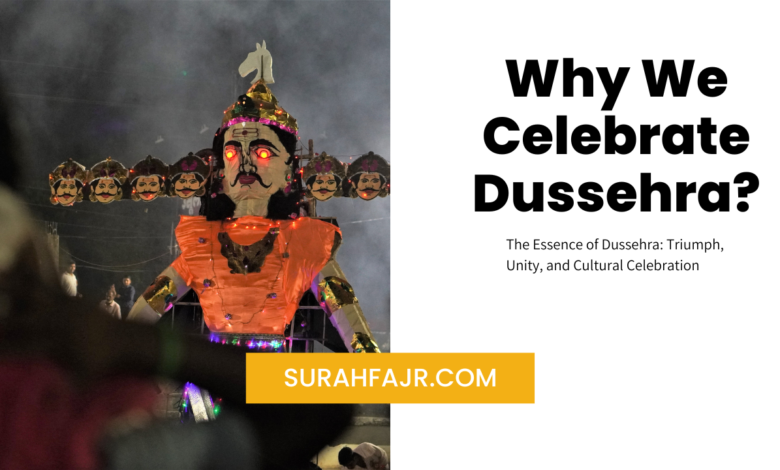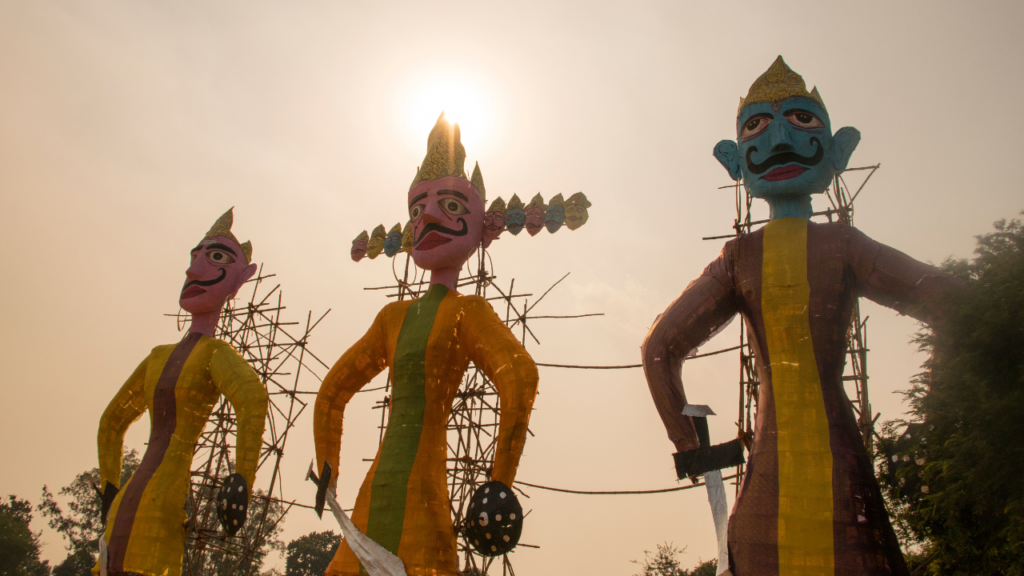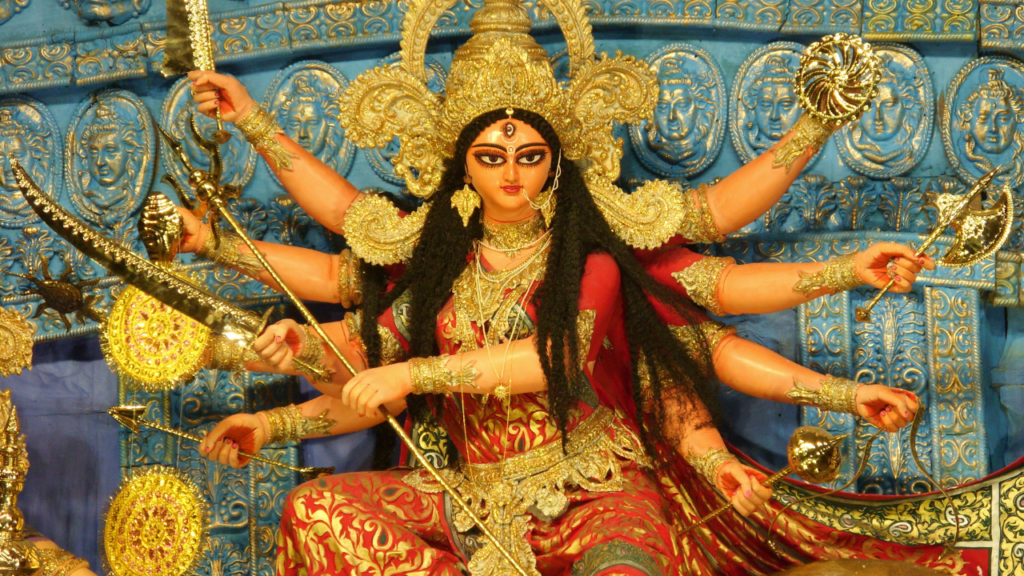Why We Celebrate Dussehra?
The Essence of Dussehra: Triumph, Unity, and Cultural Celebration

Why We Celebrate Dussehra?
Dussehra, also known as Vijayadashami, is a major Hindu festival celebrated in India and some other countries. It marks the triumph of good over evil and is observed on the tenth day of the Hindu calendar month of Ashwin.

Introduction
Dussehra, also known as Vijayadashami, is a significant Hindu festival celebrated with great enthusiasm and devotion across India and other parts of the world. This festival, which usually falls in September or October, holds a special place in the hearts of millions of people. It symbolizes the victory of good over evil and marks the end of the nine-day festival of Navratri. In this article, we will delve into the rich history and cultural significance of Dussehra, shedding light on the reasons why it is celebrated with such fervor.
Historical Background
Dussehra’s roots can be traced back to ancient Indian mythology, particularly the epic Ramayana. The most well-known narrative associated with Dussehra is the victory of Lord Rama over the demon king Ravana. According to the Ramayana, Ravana had kidnapped Rama’s wife, Sita, and took her to his kingdom in Lanka. After a long and arduous battle, Rama, with the help of his devoted ally Hanuman and an army of monkeys, defeated Ravana on the tenth day, which is celebrated as Dussehra.
Also Check
- Islamic Names For Boys
- What is Judgement day in Islam?
- How old was Mary when she had Jesus?
- Is Mike Tyson Muslim?
- What Is Shirk Islam?
Significance of Dussehra
- Triumph of Good Over Evil: Dussehra embodies the timeless concept of the victory of good over evil. The story of Rama’s victory over Ravana symbolizes the eventual triumph of righteousness over wickedness. This theme resonates with people as it serves as a reminder that, no matter how formidable the evil may seem, it will ultimately be vanquished by the forces of goodness.
- Celebration of Dharma: The Ramayana and Dussehra are deeply rooted in the concept of dharma, which refers to the moral and ethical path one must follow. Rama is seen as the epitome of dharma, and his victory signifies the triumph of righteousness and the importance of adhering to moral principles even in the face of adversity.
- Cultural Unity: Dussehra is celebrated by people of various regions, languages, and cultures throughout India. It brings people together, fostering a sense of unity and brotherhood. The shared celebration of this festival helps transcend regional and linguistic differences, emphasizing the cultural diversity that is India’s strength.
- Renewal of Faith: Dussehra is a time for people to renew their faith in the power of good and righteousness. It inspires individuals to uphold moral values and ethical conduct in their lives. The burning of effigies of Ravana, a common practice during Dussehra, serves as a symbolic act of purging evil from one’s life.
- Beginning of Festive Season: Dussehra also marks the beginning of the festive season in India, which culminates with Diwali, the festival of lights. The enthusiasm and energy associated with Dussehra create a joyous atmosphere that extends through various other festivals and celebrations.
Celebrations of Dussehra
Dussehra celebrations vary across different regions of India, but some common rituals and practices include:
- Ramlila: The enactment of scenes from the Ramayana, known as Ramlila, is a popular tradition during Dussehra. It involves elaborate plays and performances depicting Rama’s life and his battle against Ravana.
- Burning of Effigies: In many places, effigies of Ravana, along with his demon brother Kumbhakarna and son Meghnad, are set ablaze, symbolizing the destruction of evil forces. This is often followed by fireworks and celebrations.
- Worship of Weapons: On this day, people pay homage to their tools and weapons, seeking divine blessings for success and protection.
- Cultural Fairs: Many places organize cultural fairs and processions, showcasing the rich heritage and traditions of India. These fairs are a blend of art, music, dance, and delicious cuisine.
Conclusion
Dussehra is more than just a festival; it’s a celebration of the eternal battle between good and evil, a reminder of the significance of righteousness, and an opportunity to come together in unity and joy. This vibrant festival serves as a source of inspiration for people to uphold moral values and faith in the face of challenges. It encourages individuals to strive for goodness in their lives, just as Lord Rama did in the epic Ramayana. As Dussehra approaches each year, it brings with it the promise of victory over darkness and a renewed commitment to the path of righteousness.

(FAQs) about why we celebrate Dussehra?:
What is Dussehra?
Dussehra, also known as Vijayadashami, is a major Hindu festival celebrated in India and some other countries. It marks the triumph of good over evil and is observed on the tenth day of the Hindu calendar month of Ashwin.
Why is Dussehra celebrated?
Dussehra is celebrated to commemorate the victory of Lord Rama over the demon king Ravana, symbolizing the triumph of righteousness and virtue over evil and wickedness. It also marks the end of the Navaratri festival.
What is the significance of Lord Rama in Dussehra?
Lord Rama is a central figure in the epic Ramayana. His victory over Ravana, who had abducted his wife Sita, is celebrated during Dussehra to showcase the importance of upholding dharma (righteousness).
How is Dussehra celebrated in different regions of India?
Dussehra is celebrated in diverse ways across India. In the northern parts, Ramlila performances depicting the life of Lord Rama are organized, while in the southern states, it’s celebrated as Saraswati Puja. In eastern India, it’s marked with elaborate processions of the goddess Durga, and in the western regions, it’s the time for honoring tools and instruments.
Are there any customs or rituals associated with Dussehra?
Yes, there are various customs and rituals associated with Dussehra. Some of the common ones include the burning of effigies of Ravana, Meghnad, and Kumbhakarna, worshipping goddess Durga, and seeking her blessings.
What is the significance of burning effigies on Dussehra?
The burning of effigies, especially that of Ravana, signifies the victory of good over evil. It is a symbolic reenactment of Lord Rama’s destruction of Ravana, which is a key element of the Dussehra celebration.
Are there any regional variations in Dussehra celebrations?
Yes, there are regional variations in Dussehra celebrations. For example, in Mysore, Karnataka, a grand procession featuring a decorated elephant and various cultural displays is a prominent part of the celebration. Each region adds its unique cultural elements to the festival.
Is Dussehra a public holiday in India?
Dussehra is not a nationwide public holiday, but it is observed as a public holiday in some states and regions of India. Government offices and schools are often closed in areas where it is a public holiday.
Is Dussehra only a Hindu festival?
While Dussehra has its roots in Hindu mythology, it is celebrated by people of various faiths and communities in India. It is a culturally significant festival that transcends religious boundaries.
How can I participate in Dussehra celebrations in India?
To participate in Dussehra celebrations in India, you can visit local fairs, processions, and events. It’s a great opportunity to witness the rich cultural heritage and traditions of the country.





